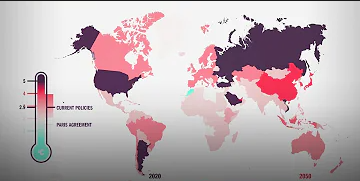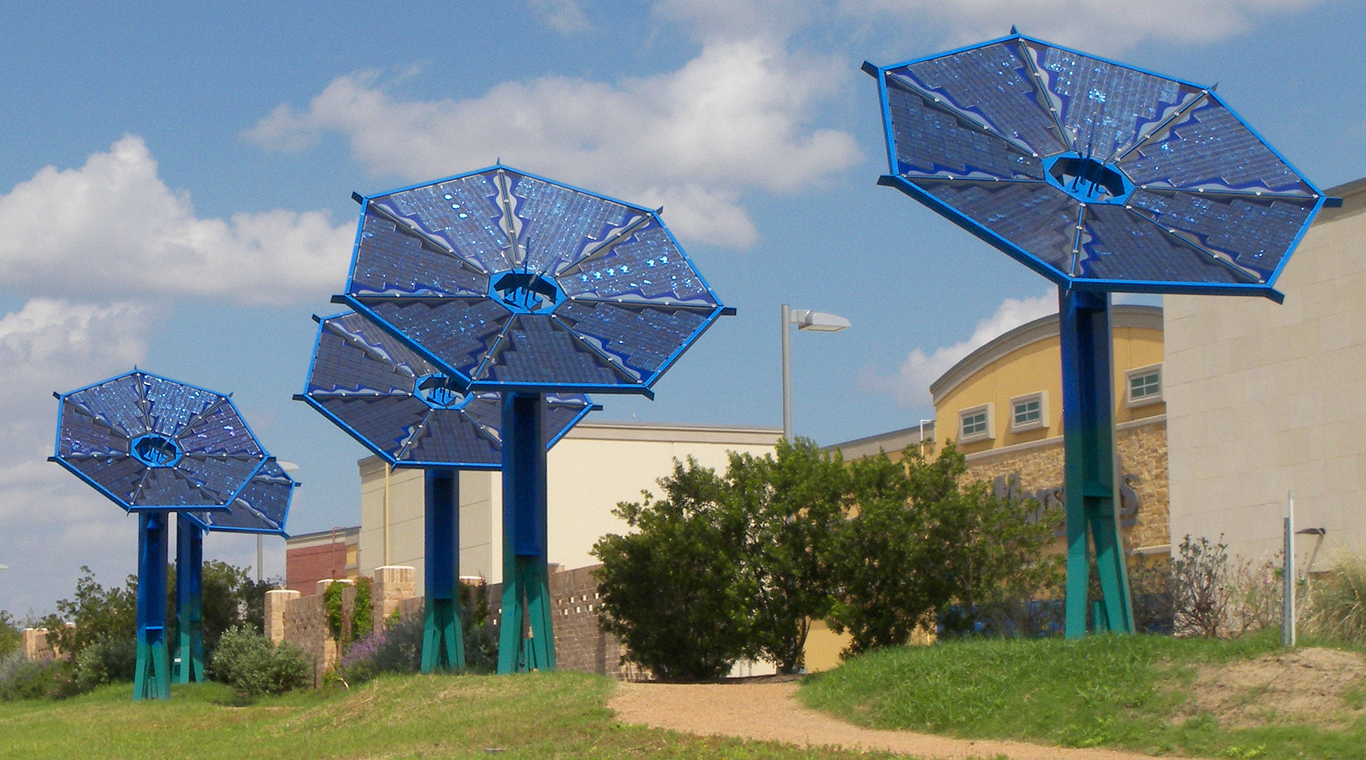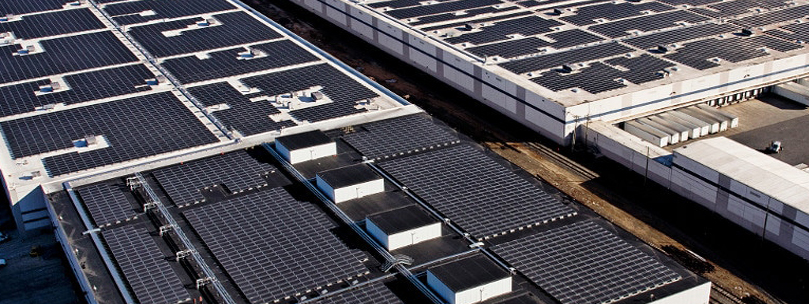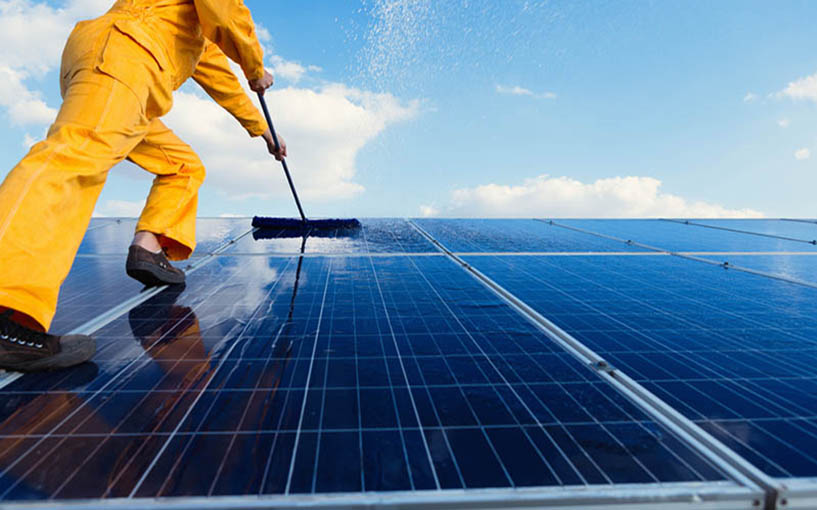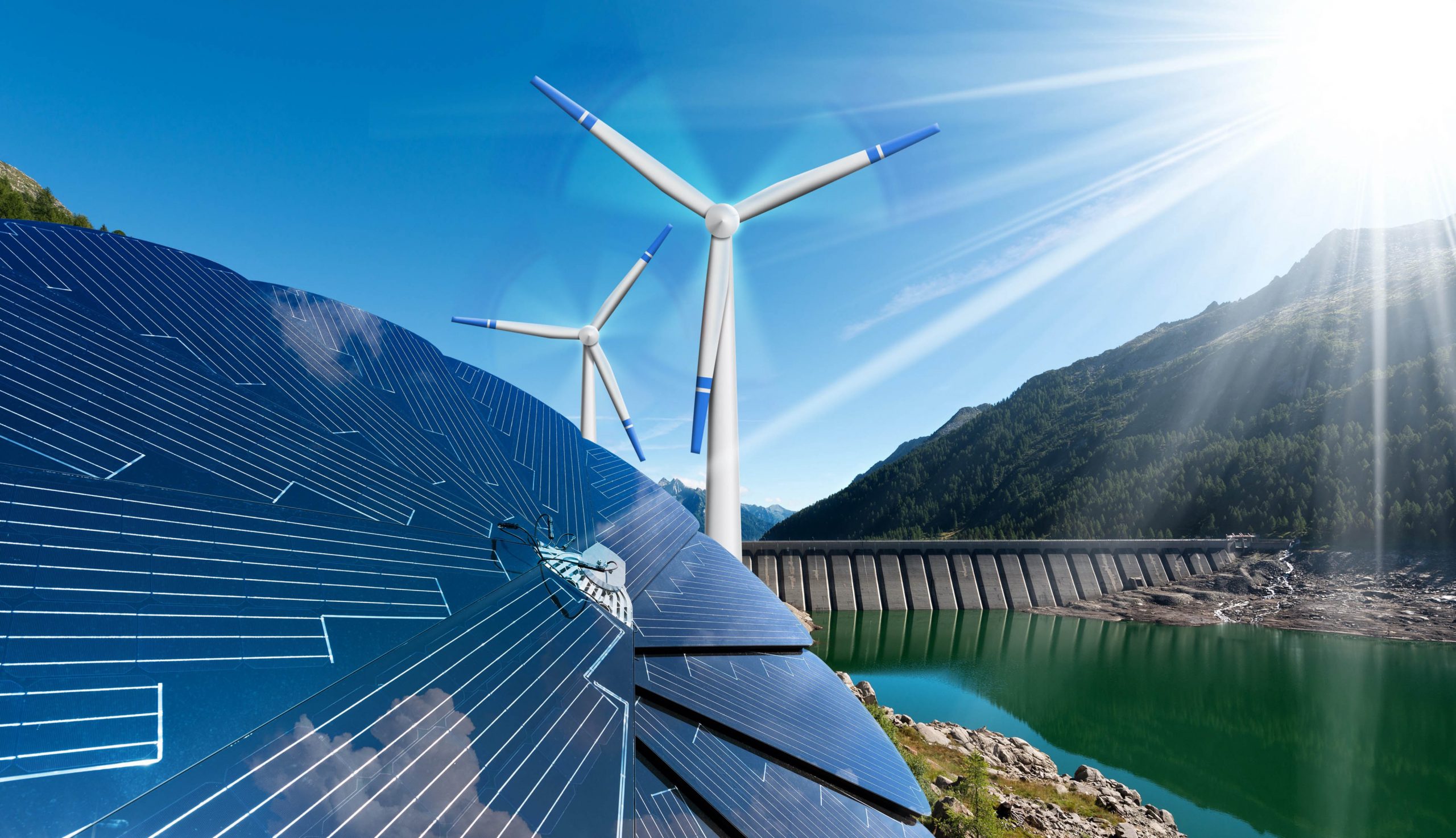Category: General Solar Energy
How Many U.S. Cities Have Gone 100% Renewable?
How Many U.S. Cities Have Gone 100% Renewable?
1. Abita Springs Abita Springs, LA is committed to transition 100% of the town’s electricity to renewable energy sources by December 31, 2030. Contact LeAnne Pinniger Magee Take Action Take Action Mayor Greg Lemons has pledged their support for a community-wide transition 100% renewable energy.
2. Amherst Amherst, MA is committed to enabling a community-wide transition to 100% clean, renewable energy and is calling on the State of Massachusetts to adopt a statewide goal of 100% renewable energy.
3. Angel Fire Angel Fire is committed to achieving 100% renewable electricity by 2030. Learn More
4. Atlanta Atlanta is committed to achieving 100% renewable electricity by 2035. Contact Marquese AverettLearn More
5. Augusta Augusta, GA is committed to achieving 100% renewable electricity by 2050. Contact Ted Terry
6. Berkeley The City of Berkeley is committed to transitioning to 100% clean, carbon-free energy by 2030, including electricity, transportation and buildings, by 2030. Contact Richard Rollins Mayor Jesse Arreguin has pledged their support for a community-wide transition 100% renewable energy.
7. Blacksburg In December 2017, Blacksburg, VA City Council adopted a goal of transitioning to 100% renewable electricity community-wide by 2050.
8. Boulder In December of 2016, Boulder City Council made the commitment to 100% renewable electricity by 2030! Contact Leslie Glustrom Take Action Take Action Mayor Suzanne Jones has pledged their support for a community-wide transition 100% renewable energy.
9. Breckenridge Breckenridge, Colorado is committed to powering municipal operations with 100% renewable energy by 2025, and a goal of 100% renewable electricity community-wide by 2035. Contact Beth Groundwater Take Action
10. Cambridge In April 2017, Cambridge committed to transition 100% clean and renewable energy community-wide, including building energy use and transportation, by 2035.
11. Chula Vista Chula Vista, CA, is committed to 100% renewable electricity community-wide by 2035. Contact Pete Hasapopoulos Mayor Mary Casillas Salas has pledged their support for a community-wide transition 100% renewable energy.
12. Clarkston Clarkston, GA is committed to a community-wide goal of transitioning to 100% renewable energy by 2050. Contact Ted Terry Mayor Ted Terry has pledged their support for a community-wide transition 100% renewable energy.
13. Cleveland Cleveland, OH is committed to 100% clean, renewable electricity by 2050. Contact Jocelyn L. Travis Take Action
14. Columbia Columbia, SC is committed to transitioning to 100% renewable electricity by 2036. Contact Chris Hall Mayor Steve Benjamin has pledged their support for a community-wide transition 100% renewable energy.
15. Concord Concord, NH, commits to 100% renewable electricity by 2030 and for all energy sectors, including heat and transportation by 2050. Contact Ally Samuell
16. Cornish Cornish, New Hampshire is committed to 100% renewable electricity by 2030, and 100% renewables for heat & transportation by 2050. Contact Ally Samuell Take Action
17. Culver City In 2019, when the LA County Community Choice Energy Program, Culver City residents and businesses will all be powered by 100% renewable energy.
18. Del Mar Del Mar, California is committed to achieving 50% renewable electricity by 2020, and 100% by 2035. Learn More Deputy Mayor D. Dwight Worden has pledged their support for a community-wide transition 100% renewable energy.
19. Denton Denton, TX is committed to achieving 100% renewable electricity community-wide as early as 2020.
20. Denver Denver, CO is committed to transitioning to 100% renewable electricity community-wide by 2030.Contact Emily Gedeon Take Action
21. Downingtown Downingtown Borough, PA commits to 100% clean renewable energy by 2035 and 100% renewable energy for heat and transportation by 2050. Contact Sarah Caspar Mayor Josh Maxwell has pledged their support for a community-wide transition 100% renewable energy.
22. Eagle Nest Eagle Nest is committed to achieving 100% renewable electricity by 2030. Learn More
23. East Hampton East Hampton, New York is committed to achieving 100% renewable electricity by 2022 and 100% renewable heating, cooling and transportation by 2030. Learn More
24. Eau Claire Eau Claire, WI is committed to transitioning to 100% renewable energy by 2050 .
25. Edmonds Edmonds, WA, is committed to 100% renewable energy for the City’s community electricity supply by 2025, and 100% renewable energy for municipal facilities by 2019. Contact Victoria Leistman
26. Encinitas Encinitas, CA adopted a comprehensive Climate Action Plan, with a goal to transition to 100% clean, renewable energy by 2030. Contact Pete Hasapopoulos Mayor Catherine Blakespear has pledged their support for a community-wide transition 100% renewable energy.
27. Eureka The City of Eureka, CA is committed to transitioning to 100% renewable electricity community-wide by 2025.
28. Fayetteville Fayetteville, AR is committed to powering all government operations with 100% clean, energy by 2030 and the entire community by 2050. Contact Glen Hooks Mayor Lioneld Jordan has pledged their support for a community-wide transition 100% renewable energy.
29. Fort Collins Fort Collins, CO is committed to 100% clean, renewable electricity community-wide by 2030.Contact Will Walters Take Action!
30. Goleta Goleta, California, is committed to 100% clean, renewable electricity for municipal facilities and community-wide supply by 2030. Contact Katie Davis Goleta: Set a 100% Clean Energy Goal
31. Hanover The Town of Hanover, New Hampshire is committed to a community-wide goal of transitioning to 100% renewable electricity by 2030 and a 2050 goal of transitioning heating and transportation to run on clean, renewable sources of energy. Contact Ally Samuell Take Action Mayor Julia Griffon has pledged their support for a community-wide transition 100% renewable energy.
32. Hillsborough The Town of Hillsborough, North Carolina commits to transition to 100% clean, renewable energy for all sectors by December 31, 2050 or sooner and 80% clean, renewable energy by 2030. And calls on The State of North Carolina to do the same! Contact Caroline Hansley
33. Kennett Township Kennett Township, PA is committed to transition to 100% clean and renewable energy community-wide by 2035 and 100% renewable energy for heat and transportation by 2050. Contact Jim Wylie
34. La Mesa La Mesa, CA is committed to transition to 100% renewable electricity by 2035 Contact Pete Hasapopoulos Mayor Mark Arapostathis has pledged their support for a community-wide transition 100% renewable energy.
35. Lafayette Lafayette, CO is committed to transition to 100% renewable energy by 2030. Contact Emily Hiltz Mayor Christine Berg has pledged their support for a community-wide transition 100% renewable energy.
36. Largo Largo, FL is committed to transition the community-wide energy supply to 100% clean and renewable energy for all, and to transition the municipal energy supply to 100% clean and renewable energy by 2040 with 50% by 2035. Contact Bryan Beckman Let’s go Largo!
37. Longmont Longmont, CO is committed to 100% clean, renewable electricity community-wide by 2030.Contact Karen Dike Longmont, CO Is Ready For 100% Renewable Energy Mayor Brian Bagley has pledged their support for a community-wide transition 100% renewable energy.
38. Lowell Lowell, MA has committed to transitioning to 100% renewable energy by 2035.
39. Madison Madison, WI has committed to transitioning to 100% renewable electricity community-wide by 2050. Contact Elizabeth Katt Reinders
40. Menlo Park Menlo Park has committed to transitioning to 100% renewable electricity community-wide by 2030, and is setting the example today by already powering all municipal operations with 100% renewable energy. Contact Diane Bailey Mayor Kirsten Keith has pledged their support for a community-wide transition 100% renewable energy.
41. Middleton Middleton, WI is committed to transitioning to 100% renewable electricity by 2040 and 100% renewable energy sources for all energy sectors by 2050. Contact Elizabeth Ward
42. Minneapolis Minneapolis, MN has committed to 100% renewable electricity for municipal facilities and operations by 2022, and 100% renewable electricity for community-wide by 2030. Contact Alexis BoxerMayor Jacob Frey has pledged their support for a community-wide transition 100% renewable energy.
43. Moab Moab is committed to transitioning to 100% renewable electricity by 2032. Contact Lindsay Beebe
44. Monterey Monterey is committed to transition to renewable electricity community-wide by 2040. Learn More Mayor Clyde Roberson has pledged their support for a community-wide transition 100% renewable energy.
45. Nederland Nederland, Colorado is committed to 100% clean, renewable electricity community-wide by 2025. Contact Eryka Thorley
46. Nevada City Nevada City, California, commits to transition to 100% renewable energy for its community electricity supply by 2030, and 100% renewable energy in all sectors including transportation and heating systems by 2050!
47. New Brunswick New Brunswick, NJ is committed to 100% clean, renewable electricity community-wide by 2035.
48. Norman The City of Norman, OK committed to 100% clean energy in the form of wind, solar, energy efficiency measures and other renewable sources within the electricity sector by 2035 and all energy-use sectors including heating and transportation by 2050. Contact Adrienne Gautier
49. Northampton Northampton, MA is committed to enabling a community-wide transition to 100% clean, renewable energy and is calling on the State of Massachusetts to adopt a statewide goal of 100% renewable energy.
50. Ojai Ojai, CA is committed to 100% clean, renewable electricity. Mayor John F. Johnston has pledged their support for a community-wide transition 100% renewable energy.
51. Orlando The city of Orlando, Florida, is committed to 100% clean, renewable energy by 2030 and community-wide 100% clean electricity by 2050! Contact Phil Compton VICTORY: Orlando Set a 100% Clean Energy Goal! Mayor Buddy Dyer has pledged their support for a community-wide transition 100% renewable energy.
52. Palo Alto Since 2013, Palo Alto, California’s electricity is 100% carbon neutral. Learn More Mayor Greg Scharff has pledged their support for a community-wide transition 100% renewable energy.
53. Park City Park City, UT is committed to transition to 100% renewable electricity by 2032. Contact Lindsay Beebe Learn More Mayor Jack Thomas has pledged their support for a community-wide transition 100% renewable energy.
54. Phoenixville Phoenixville, Pennsylvania commits to transition to 100% clean and renewable electricity by 2035 and 100% renewable energy for heat and transportation by 2050. Contact Paula Kline Mayor Michael J. Speck has pledged their support for a community-wide transition 100% renewable energy.
55. Plainfield Plainfield, New Hampshire is committed to 100% renewable electricity by 2030, and 100% renewable energy for heat & transportation by 2050. Contact Evan and Lee Oxenham Take Action
56. Portland Portland, Oregon is committed to transition to 100% renewable electricity community-wide by 2035, and to meet all energy needs, including transportation, heating and cooling, and electricity, with 100% renewable energy by 2050. Contact Laura Stevens
57. Pueblo Pueblo, CO is committed to transitioning to a healthy, affordable 100% renewable energy system with greater community control and equitable access by 2035. Contact Jory Miller Take Action
58. Questa Questa is committed to achieving 100% renewable electricity by 2030. Learn More
59. Red River Red River is committed to achieving 100% renewable electricity by 2030. Learn More
60. Salt Lake City Salt Lake City, Utah is committed to achieving 100% renewable energy for community electricity supply by 2032 and 50% renewable electricity for municipal operations by 2020. Contact Lindsay Beebe Learn More Mayor Jackie Biskupski has pledged their support for a community-wide transition 100% renewable energy.
61. San Diego San Diego is committed to 100% renewable electricity by 2035. Learn More Mayor Kevin Faulconer has pledged their support for a community-wide transition 100% renewable energy.
62. San Francisco San Francisco is committed to achieving 100% renewable electricity by 2030. Contact Melissa Yu Learn More Mayor London Breed has pledged their support for a community-wide transition 100% renewable energy.
63. San Jose San Jose, California is committed to achieving 100% renewable electricity by 2050. Learn MoreMayor Sam Liccardo has pledged their support for a community-wide transition 100% renewable energy.
64. San Luis Obispo San Luis Obispo is committed to 100% carbon-free, clean electricity by 2035.
65. Santa Barbara The Santa Barbara City Council approved a measure that establishes a community-wide goal of transitioning to 100 percent renewable electricity by 2030. The resolution also commits the city to transition all municipal buildings and operations to 50 percent clean electricity by 2020. Contact Katie Davis Take Action Mayor Helene Schneider has pledged their support for a community-wide transition 100% renewable energy.
66. Sarasota Sarasota FL is committed to achieving 100% zero-emission, renewable electricity by 2045.Contact Phil Compton Mayor Shelli Freeland Eddie has pledged their support for a community-wide transition 100% renewable energy.
67. Solana Beach Solana Beach has committed to transitioning to 100% renewable electricity community-wide by 2035. Contact Pete Hasapopoulos Learn More
68. South Lake Tahoe South Lake Tahoe is committed to transitioning entirely to renewable sources of electricity by 2032. Contact John Friedrich
69. Southampton Town of Southampton has committed to meet 100% of the community-wide electricity consumption needs through renewable energy sources by the year 2025. Learn More
70. Spokane Spokane, WA is committed to transitioning 100% clean, renewable energy for the City’s community electricity supply by 2030.
71. St. Louis St. Louis, Missouri, commits to transition to 100% clean energy in the form of wind and solar and energy efficiency measures within the electricity sector by 2035. Contact Sara Edgar Take Action
72. St. Louis Park St. Louis Park, MN is committed to transitioning to 100% renewable electricity by 2030.
73. St. Paul St Paul, MN is committed to 100% renewable electricity community-wide by 2030.
74. St. Petersburg St. Petersburg is committed to transitioning to 100% renewable electricity. Contact Lisa Hinton Mayor Rick Kriseman has pledged their support for a community-wide transition 100% renewable energy.
75. Taos The City of Taos, NM is committed to transitioning its electricity to 100% renewable energy by 2030.Learn More
76. Taos Ski Valley Taos Ski Valley is committed to achieving 100% renewable electricity by 2030. Learn More
77. Traverse City Traverse City, MI is committed to 100% clean, renewable electricity by 2040. Contact Jordan Chrispell Mayor Jim Carruthers has pledged their support for a community-wide transition 100% renewable energy.
78. Truckee The Town of Truckee, California is committed to achieve 100% renewable electricity for municipal facilities by 2020, 100% renewable electricity town wide by 2030, as well as all energy sources by 2050. Contact Brian Beffort Mayor Morgan Goodwin has pledged their support for a community-wide transition 100% renewable energy.
79. West Chester West Chester Borough, Pennsylvania, is committed to transition community-wide to 100% clean renewable electricity by 2035 and 100% renewable energy for heat and transportation by 2050.Contact Jim Wylie Mayor Jordan Norley has pledged their support for a community-wide transition 100% renewable energy.
80. Windsor The town of Windsor, Massachusetts has committed to 100% renewable electricity community-wide.
Cities Powered by 100% Renewable Energy
81. Aspen As of 2015, Aspen, Colorado is powered by 100% renewable electricity – a mix of approximately 50% wind, 45% hydropower, and the remaining 5% from solar and landfill gas. Contact Emily Hiltz Learn More Mayor Steve Skadron has pledged their support for a community-wide transition 100% renewable energy.
82. Burlington As of 2014, Burlington, Vermont is powered by 100% renewable electricity. Learn More Mayor Miro Weinberger has pledged their support for a community-wide transition 100% renewable energy.
83. Georgetown As of 2018, Georgetown, TX is powered by 100% renewable electricity. Learn More Mayor Dale Ross has pledged their support for a community-wide transition 100% renewable energy.
84. Greensburg As of 2013, Greensburg, Kansas is powered with 100% renewable electricity. Learn MoreMayor Bob Dixson has pledged their support for a community-wide transition 100% renewable energy.
85. Kodiak Island Since 2012, Kodiak Island is powered by 100% renewable electricity.
86. Rock Port Rock Port, MO is powered by 100% wind energy.
Counties Committed to 100% Renewable Energy
1. Buncombe County Buncombe County, North Carolina, commits to the goal of 100% clean, renewable energy for municipal operations by 2030, and for the larger community and county by 2042.
2. Floyd County Floyd County, VA adopted a commitment to 100% clean, renewable energy on October 24, 2017.
3. Multnomah County Multnomah County, Oregon is committed to transition to 100% renewable electricity community-wide by 2035, and to meet all energy needs, including transportation, heating and cooling, and electricity, with 100% renewable energy by 2050. Contact Laura Stevens
4. Orange County North Carolina, Orange County Board of Commissioners passed a resolution committing the County, the State, and the United States to a 100% clean renewable energy for all energy sectors-based economy, by January 1, 2050 or sooner. Contact Caroline Hansley
5. Pueblo County Pueblo County, CO is committed to 100% renewable electricity county-wide by 2035.Contact David Cockrell
6. Summit County Summit County, Utah, is committed to transitioning to net-100% renewable electricity across the county by 2032. Contact Lindsay Beebe
7. Summit County Summit County, CO adopts a resolution for 100% clean, renewable energy community-wide by 2035. Contact Kent Abernathy
8. Taos County Taos County is committed to achieving 100% renewable electricity by 2030. Learn More
9. Whatcom County Whatcom County, WA adopted an ordinance that commits the County to transition County Operations and the larger Whatcom County community to 100% renewable electricity.
States Committed to 100% Renewable Energy
1. Hawaii Hawaii is the first state in the U.S. to set a state-wide goal of 100% renewable electricity by 2045Contact Jodi Malinoski
2. California California is the second state in the U.S. to set a state-wide goal of 100% renewable electricity by 2045 Contact Evan Gillespie
What does it mean to be committed to, powered by, or working towards 100% clean, renewable energy?
Committed to 100% Renewable Energy:
The Ready for 100 Campaign recognizes community commitments as places where a city’s leadership has established a goal to transition to the entire community to 100% clean, renewable energy. This can be through a stand-alone Resolution or Proclamation or integrated into a community’s Climate Action Plan or Energy Action Plan.
100% Commitment Guidelines
When crafting a commitment to 100% renewable energy, Ready For 100 recommends that the adopted goal includes the following elements:
- Community-wide Electricity Use: A full transition of the electricity sector to clean, renewable energy;
- By 2035: A target year for when this commitment will be achieved no later than 2035 for electricity and 2050 for all energy sectors;
Ensure Justice, Equity, Affordability, and Access: A commitment should include measures that prioritize equity affordability, and access for all members of the community, prioritizing low-income communities, environmental justice communities, and communities burdened by the fossil fuel industry. - Clean and Renewable Resources Only: This includes carbon and pollution-free energy sustainably collected from renewable sources including wind, solar, tidal, and geothermal. Low-impact, small hydro, and some forms of biomass may be included after being evaluated for sustainability and environmental justice implications. Nuclear, natural gas, coal, oil-based, or any other forms of carbon-based energy production are not included as clean or renewable sources of energy. Sierra Club’s complete energy policy can be found here.
- A Transparent and Inclusive Planning and Implementation Process ensuring that the community members and local businesses have an opportunity to participate.
Strong commitments also include:
- All Energy Sectors: A commitment to transition other energy sectors to 100% including transportation and heating and cooling;
- A Local Generation Goal: A goal for how much of the community’s energy needs will be met by local, distributed generation;
- Near term implementation steps: At least the first year and ideally a five year plan;
- Commitment to Collaboration: A commitment to work with surrounding communities in achieving aligned clean energy and equity goals;
- Commitment to Advocate: A commitment to advocate for policies or regulations at the state, regional and/or federal level that aid the city in their transition
Powered by 100% Renewable Energy:
A community is powered with 100% renewable energy when the amount of energy generated from renewable energy sources in the community (or brought into it) equals or exceeds 100% of the annual energy consumed within the community.
Working towards 100% Renewable Energy:
A number of communities have pledged support for 100% clean energy, and some are demonstrating support for a transition to 100% clean energy by investing in renewable energy for municipal operations. To see a list of cities that have invested in renewable energy for their municipal operations check out EPA’s Green Power Communities. To see a list of businesses, communities, and countries that are working towards 100% visit Go 100% Renewable Energy.
10 Reasons to Go Solar in Austin, Texas
10 Reasons to Go Solar in Austin, Texas
1. Say Goodbye to Huge Electric Bills
Solar helps you greatly reduce or even totally eliminate your monthly electric bill.
2. Increase Your Property Value
Solar panels can do more than just pay for themselves by increasing the value of your home. In addition, they will make your house more attractive to perceptive home buyers.
3. Help Create Jobs
By going solar, you are contributing to solar industry job creation.
4. It’s Better for the Environment
Unlike conventional electricity, solar energy does not pollute. Lower your carbon footprint and gain peace of mind from knowing you’re doing the right thing for our planet.
5. Tax Incentives
The federal government offers great tax incentives that encourage consumers to go solar. If you have a solar system installed, you could be eligible for 30% tax credit.
6. Help the U.S. Become Energy Independent
Solar power can help U.S. become less dependent on oil coming from foreign countries.
7. Protect Your Roof
Solar panels can you help you save tons of money on roof repairs by protecting your roof from harsh weather.
8. Escape Ramping Up Energy Bills
Does it seem to you that your electric bills are going up? Are you struggling with predicting these jumps? Then solar is the right choice for you. Your solar installation comes with a steady, convenient payment plan. No extra charges or hidden fees!
9. Solar is Dependable and Reliable
The latest innovations in the solar industry provide customers with
Modern solar technology provides customers with consistent, trustworthy, and reliable energy.
10. Be a Trendsetter!
In a couple of years, solar will be everywhere. Be one of the early adopters to set an example for the next generations and show your friends and neighbors the way to renewable energy.
Already excited about solar? Check if your home qualifies today!
It’s 100% free to see if your home qualifies, and takes about two short minutes.
Answer a few questions to find out if your area qualifies, and how much “going solar” can mean to your wallet.
Biden’s tax plan shifting U.S. fossil fuel subsidies
Biden’s tax plan shifting U.S. fossil fuel subsidies
U.S. Treasury Secretary Janet Yellen on Wednesday released an outline of a tax hike proposal that would lower subsidies for fossil fuel companies while increasing incentives for clean energy in President Joe Biden’s infrastructure plan.
A Treasury Department office estimated that eliminating subsidies for fossil fuel companies would boost government tax receipts by more than $35 billion in the coming decade.
The “Made In America” tax plan did not specify specific tax breaks for fossil fuel companies that would be targeted. It said the historical subsidies undermine long-term energy independence and align with factors creating climate change
One of the top fossil fuel breaks is called intangible drilling costs, which allows producers to deduct most costs from drilling new wells. The Joint Committee on Taxation, a nonpartisan congressional panel, has estimated that ditching it could generate $13 billion over 10 years.
The Biden tax plan would advance clean electricity production by providing a 10-year extension of the production tax credit and investment tax credit for clean energy generation, such as wind and solar power, and energy storage. It will also create a tax incentive for long-distance transmission lines used to create an eco-friendly smart grid across the United States.
The plan would restore a tax on polluters to pay for Environmental Protection Agency costs associated with Superfund toxic waste sites, addressing the harm caused by fossil fuel production.
Greenpeace, an environmental group, said the plan does not go far enough, citing a study here calculating that U.S. fossil fuel companies get $62 billion a year in implicit subsidies for not having to pay for the damage their products do to the climate and human health.
The plan would restore a tax on polluters to pay for Environmental Protection Agency costs associated with Superfund toxic waste sites, addressing the harm caused by fossil fuel production.
Greenpeace, an environmental group, said the plan does not go far enough, citing a study here calculating that U.S. fossil fuel companies get $62 billion a year in implicit subsidies for not having to pay for the damage their products do to the climate and human health.
Solar Panel Care and Maintenance Tips
The following four tips are all you need to know about solar panel care and cleaning.
One of the big advantages of solar energy systems is the fact that they require so little care or maintenance. With no moving parts, solar installations undergo very little degradation over time. Engineering.com reports that the life expectancy of solar panels has increased in recent years as the manufacturing process and technology have become more sophisticated. The old rule of thumb used to be that panels would lose 1 percent of their effectiveness with each passing year, but that figure has now substantially decreased to half a percent. Now that solar panels are being made with monocrystalline silicon, they will maintain 92 percent of their efficiency after 20 years.
Inspect Your Solar Panels Regularly
For the most part, solar panels are placed in locations where they are not vulnerable to ground-level damage. However, it’s a good practice to give your panels a close-up inspection from time to time, in order to make sure you’re not losing power due to a buildup of pollen or tree material. The same type of dirt that accumulates on your windows will eventually find its way to your solar panels, so it makes sense to check their cleanliness now and then. Also, in rare instances, solar panels have been known to suffer damage due to extreme hail storms.
Clean and Care for Your Solar Panels
In most cases, rain and weather will take care of keeping your panels clean. This is especially true when solar panels are installed at a steeper tilt, because dust and pollen will typically be washed off with every rainfall. If your panels do happen to acquire an unusually heavy coating of dust or pollen, however, you can easily clean them with plain water and a little mild dish soap or you can just direct the hose spray up to their panels and shower them off, imitating the action of rain.
The main thing to watch out for is any danger of scratching the glass because this can reduce the light that gets to the solar cells. For this reason, when you choose solar panel cleaning products, it’s important to avoid any type of abrasive cleanser. Detergent cleansers can also be problematic because they can leave streaks and smudges that may be hard for you to see. These can also decrease the light that passes through. Rubbing alcohol dissolved in water can take care of any oily residue or other dirt that may have found its way onto the glass. If you’re going to wipe down your panels, you should generally use a soft cloth or squeegee. Since solar panels are made of glass, you don’t need to shop for specialized solar panel care or cleaning tools.
Sun and Shade Monitoring
To maintain maximum effectiveness, your solar panels have to be in the sun for as many hours as possible. When they are installed, they will be placed in a location that gets maximum sun exposure. However, trees can grow over the years and the patterns of sun and shade can change. New construction on adjacent lots may also have an effect on how much sun your installation gets. Because of this, during the lifetime of your panels, it’s important to make sure that they are still located with the best possible sunlight orientation.
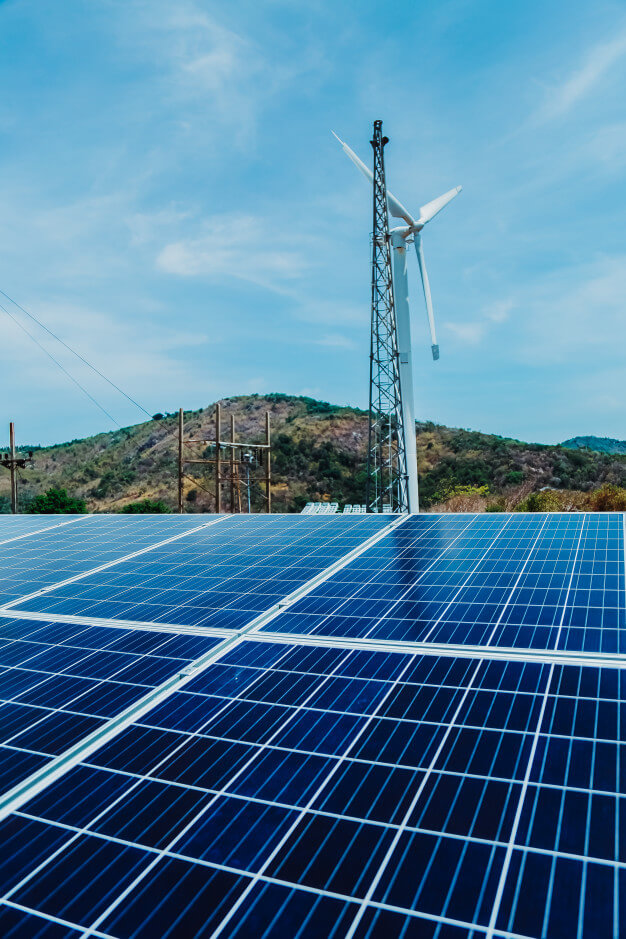
Checking Energy Usage
You may not feel that you need to check your own energy usage, since your net metering arrangement with the local utility company will show you how much energy you’re selling back to the grid. The downfall of relying solely on their numbers, however, is that you’re not directly measuring the energy output of your panels. Installing an energy monitor is your most direct way to make sure your entire system is performing correctly.
All of our solar systems allow you to monitor your energy usage. Inverters show your immediate power output as well as some daily and cumulative data.
If you love apps, rest assured that many monitoring devices would provide you with remote data, so you can pick up your phone and check on how your panels are doing at any moment. Various information-gathering and analytic operations can be performed by dedicated data-logging hardware that can be connected to your inverter. These devices may perform the operations internally, or they may send the information to your computer and use its software to provide you with useful charts and logs. The more complex levels of data tracking are certainly not a requirement for maintaining your home solar installation, but many new solar panel owners are fascinated by observing the performance of their systems.
Solar, wind expanding rapidly in US market
Solar, wind expanding rapidly in US market
The Solar industry’s growth has accounted for nearly 3.4% of the total US generation thus far this year, with wind contributing 8.5%. Coal, meanwhile, has plunged from about 30% last year to just 17.8%.
2020 has witnessed strong growth of renewable generation and rapid declines in fossil-fuel production and consumption, the U.S. Energy Information Administration’s (EIA) Electric Power Monthly report states that solar and wind are the fastest-growing sources of U.S. electricity.
This summer, solar, accounted for 3.5% of the nation’s total energy generation, up nearly 20% from 2.8% in July 2019. In the January-July 2020 period, solar accounted for nearly 3.4% of the country’s generation, up 22.1% from the 2019 year-to-date mark of 2.6%.
All renewable energy sources are taken into account, clean energy made up 9.5% of all electricity generation in July and renewables with hydroelectric provided 21.2% of total electrical output, up from 19.2% a year ago.
The 2020 highpoint happened in May, where renewable resources reached an all-time peak contribution of the country’s electricity generation at 25.3%. These gains have been driven by the growth of wind and solar.
2020 has witnessed strong growth of renewable generation and rapid declines in fossil-fuel production and consumption, the U.S. Energy Information Administration’s (EIA) Electric Power Monthly report states that solar and wind are the fastest-growing sources of U.S. electricity.
This summer, solar, accounted for 3.5% of the nation’s total energy generation, up nearly 20% from 2.8% in July 2019. In the January-July 2020 period, solar accounted for nearly 3.4% of the country’s generation, up 22.1% from the 2019 year-to-date mark of 2.6%.
All renewable energy sources are taken into account, clean energy made up 9.5% of all electricity generation in July and renewables with hydroelectric provided 21.2% of total electrical output, up from 19.2% a year ago.
The 2020 highpoint happened in May, where renewable resources reached an all-time peak contribution of the country’s electricity generation at 25.3%. These gains have been driven by the growth of wind and solar.

Solar Industry Sets Records in 2020
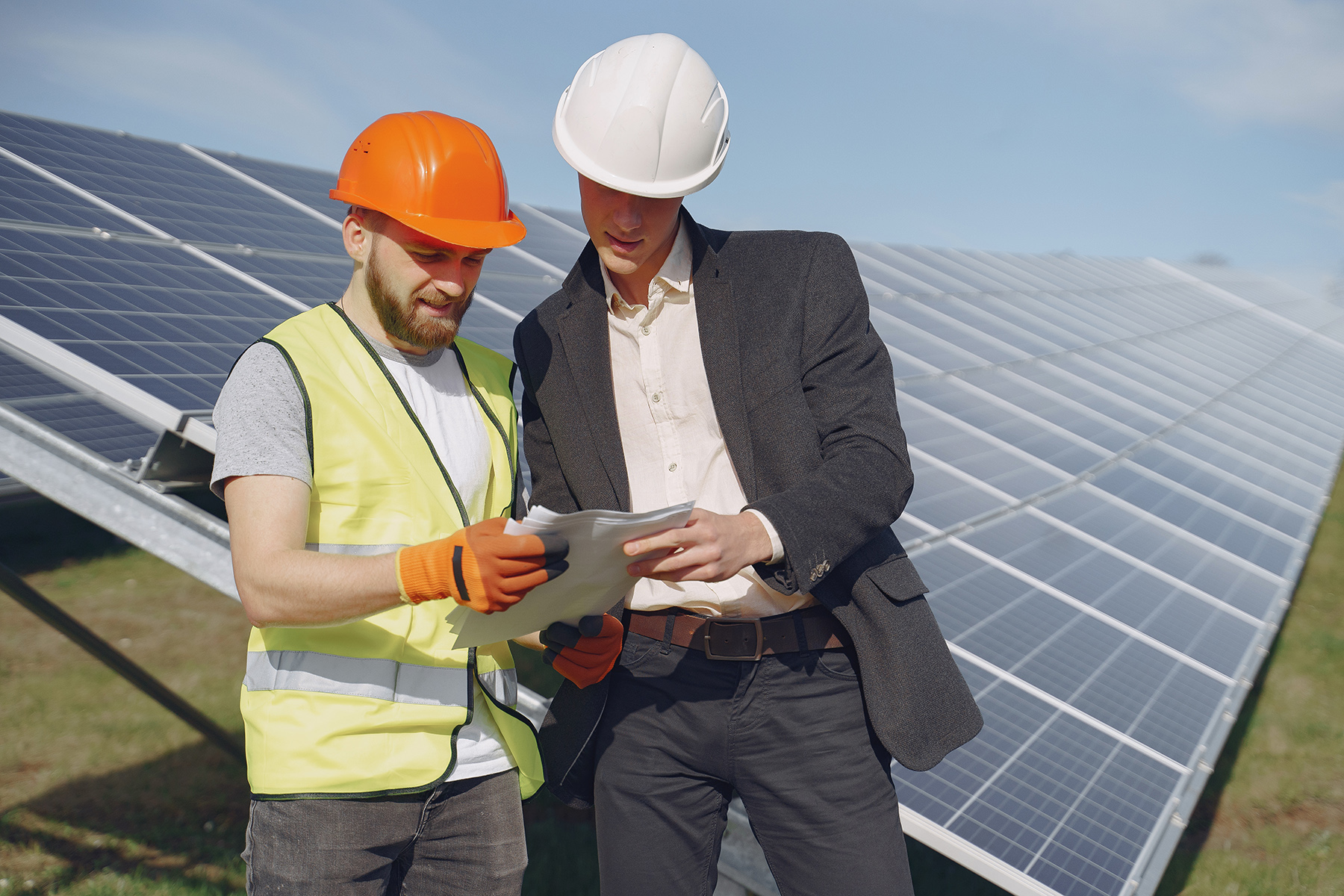
Solar Industry Sets Records in 2020, On Track to Quadruple by 2030
Tuesday, Mar 16 2021
WASHINGTON, D.C. and HOUSTON, TX — The U.S. solar industry grew 43% and installed a record 19.2 gigawatts (GWdc) of capacity in 2020, according to the U.S. Solar Market Insight 2020 Year-in-Review report, released today by the Solar Energy Industries Association (SEIA) and Wood Mackenzie.
For the second year in a row, solar led all technologies in new electric-generating capacity added, accounting for 43%. According to Wood Mackenzie’s 10-year forecast, the U.S. solar industry will install a cumulative 324 GWdc of new capacity to reach a total of 419 GWdc over the next decade.
“After a slowdown in Q2 due to the pandemic, the solar industry innovated and came roaring back to continue our trajectory as America’s leading source of new energy,” said SEIA president and CEO Abigail Ross Hopper. “The forecast shows that by 2030, the equivalent of one in eight American homes will have solar, but we still have a long way to go if we want to reach our goals in the Solar+ Decade. This report makes it clear that smart policies work. The action we take now will determine the pace of our growth and whether we use solar to fuel our economy and meet this climate moment.”
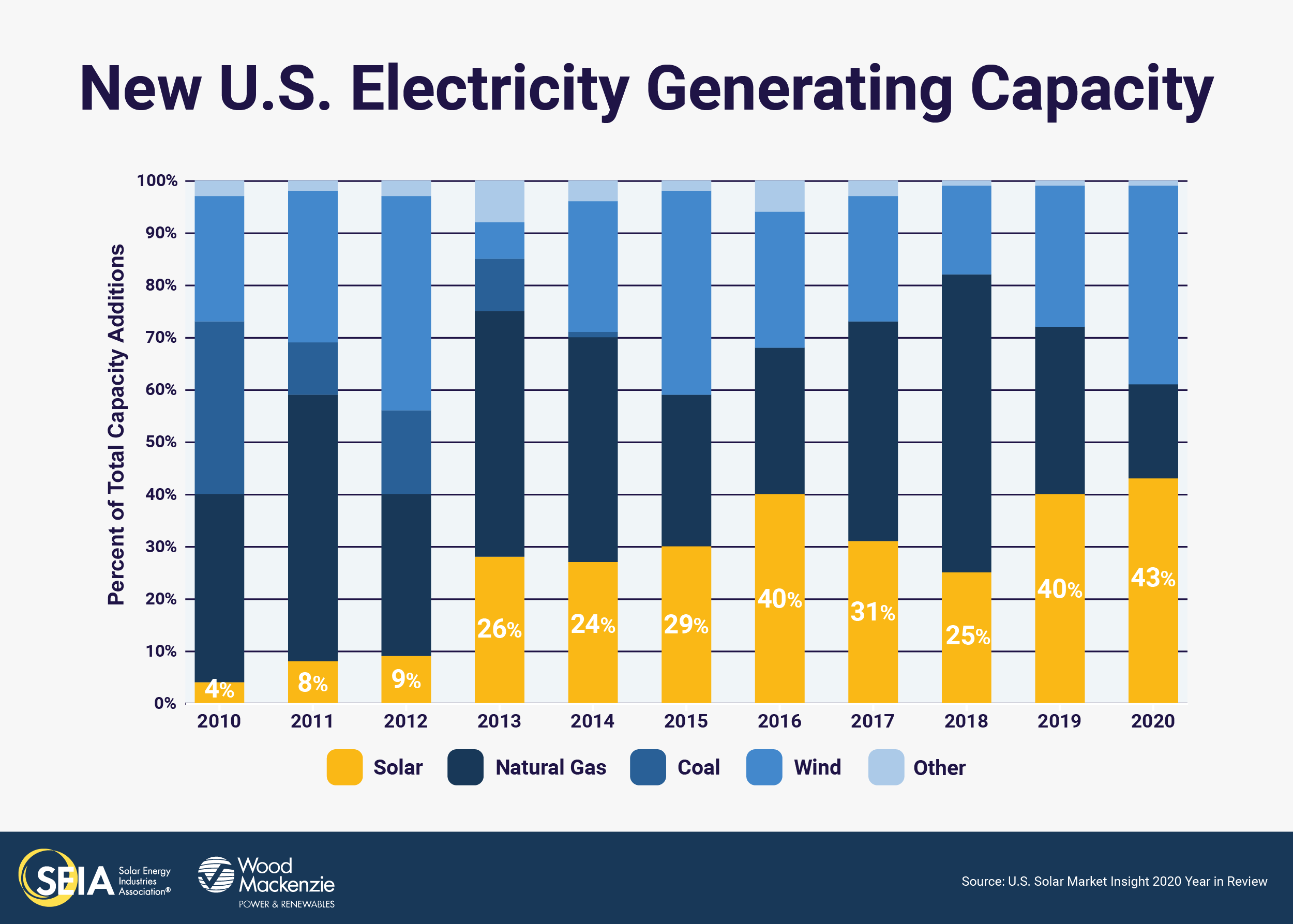
The 8 GWdc of new installations in Q4 2020 marks the largest quarter in U.S. solar history. For perspective, the U.S. solar market added 7.5 GWdc of new capacity in all of 2015. New capacity additions in 2020 represent a 43% increase from 2019 and breaks the U.S. solar market’s previous record of 15.1 GWdc set in 2016.
This is the first time Wood Mackenzie has released a long-term forecast as part of the U.S. Solar Market Insight report series. By 2030, Wood Mackenzie is forecasting that the total operating solar fleet will more than quadruple.
“The recent two-year extension of the investment tax credit (ITC) will drive greater solar adoption through 2025,” said Michelle Davis, senior analyst from Wood Mackenzie. “Compelling economics for distributed and utility-scale solar along with decarbonization commitments from numerous stakeholders will result in a landmark installation rate of over 50 GWdc by the end of the decade.”
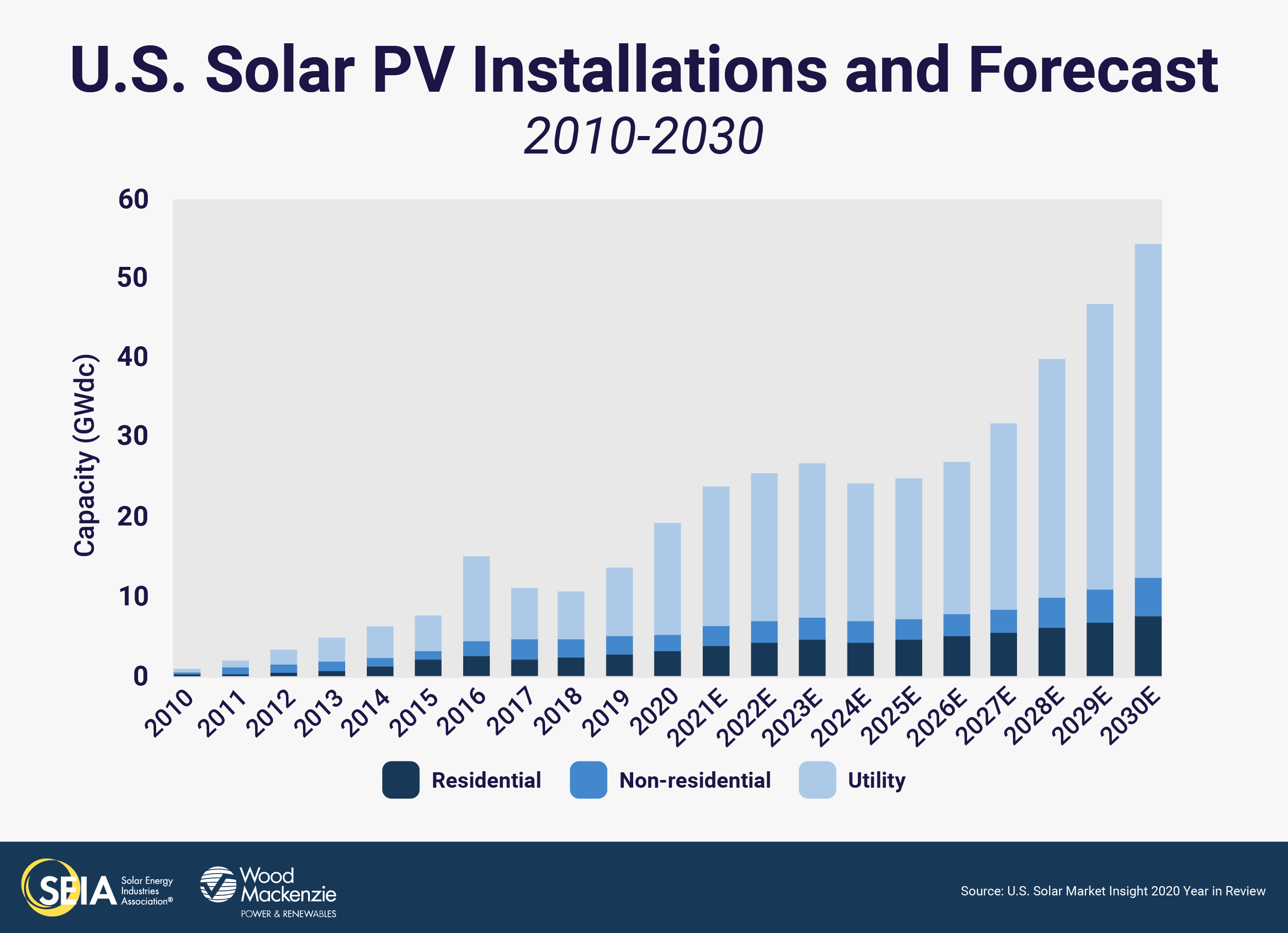
California, Texas and Florida are the top three states for annual solar capacity additions for the second straight year, and Virginia joins them as a fourth state installing over 1 GWdc of solar PV. In 2020, 27 states installed over 100 MWdc of new solar capacity, a new record.
Key Figures:
- Residential deployment was up 11% from 2019, reaching a record 3.1 GW. This was lower than the 18% annual growth in 2019, as residential installations were significantly impacted by the pandemic in the first half of 2020.
- Non-residential installations declined 4% from 2019, with 2 GW installed. The pandemic impacted this segment through delayed project interconnections and prolonged development timelines.
- There was a historic 6.3 GWdc of utility-scale projects installed in Q4 2020, bringing the annual total just shy of 14 GWdc.
- A total of 5 GWdc of new utility solar power purchase agreements were announced in Q4 2020, bringing the volume of project announcements in 2020 to 30.6 GWdc and the full utility-scale contracted pipeline to 69 GWdc.
- The 2-year extension of the ITC in the final days of 2020 has led to a 17% increase in deployment in our 2021 – 2025 forecast.
The Future Of Clean Energy: Self-Healing Solar Panels

A material used commonly in solar panels has been seen to repair itself when damaged, and scientists think this ability may be critical for the future of clean energy.
The substance, called antimony selenide (Sb2Se3) aka the solar absorbing material that can be used to turn light into electricity. The findings from the University of York, UK raise the possibility that it may be possible to create long-lasting solar panels. According to the research team, the panels could not only self-heal when damaged but also reduce costs and improve scalability.
Currently, solar panels have an average lifespan of between 25 and 35 years. The new technology of self-healing substance, could be a critical breakthrough. Professor Keith McKenna, who led the research, explains antimony selenide’s self-healing capability is analogous to a starfish or reptile that can regrow a limb after an accident. He adds that antimony selenide can repair broken bonds created when it is cleaved by forming new ones. Plus, the ability is as unusual in the materials world as it is in the animal kingdom and has important implications for applications of these materials in optoelectronics and photochemistry.
The adoption of Solar power is growing around the world at an unprecedented speed and many governments are pledging to reach net-zero over the next 10 to 30 years, and securing reliable alternatives to fossil fuels seems critical.
Researchers at GlobalData believe that space-based solar power (SBSP) may be the key to a total transition to green energy. SBSP works on using mirror-like reflectors, which are placed on satellites that move around Earth’s orbit. The reflectors would concentrate the sun’s energy onto solar panels, and allow for power to be harnessed outside of daylight hours. At the moment, solar panels collect power for an average of 29% of the day, but SBSP would mean they could be illuminated 99% of the time.
For now, SBSP is conceptual, and scientists believe it could be a reality soon. The US Naval Research Laboratory conducted its first test in this field in May 2020. Earlier this year, scientists in South Korea created the first fully transparent solar panel, which is said to be a major step forward for domestic solar power usage. Traditionally, they are opaque because of the semiconductor layers within the cells, but the research team at Incheon University could use titanium dioxide and nickel oxide instead. In 2020, double-sided solar panels were developed for the first time, which were 35% more effective.

Maintenance Tips for Solar Panels

Maintenance Tips for Solar Panels
If you have solar panels on your home, you have made a good decision. Not only are you saving on energy costs every year, but you have very little upkeep to worry about! Solar panels are very easy to care for. The front of a solar panel made out of tempered glass and will hold up well in tough conditions. . Outside of an occasional wash, you don’t really have anything to worry about.
Don’t worry about cleaning if it rains regularly where you live. If it rains where you live , you really don’t need to clean your panels. The rainwater will be enough to wash away any dust or debris from your solar panels. It’s not recommended to use strong soap on your solar panels anyway, so it’s usually unnecessary to get up there and scrub the panels manually.
- Solar panels are made out of tempered glass, which tends to be pretty resilient. Still, it’s best to take a quick look from the ground after any hail storms or thunderstorms to look for cracks. If you ever have a cracked panel, contact the installation company to have it repaired. Solar panels are typically covered by warranty for 10-25 years.
- To make a long story short, you probably aren’t losing that much power even if the panels are filthy. One study found that solar panels produce 96-98% of the energy they’d normally produce when they’re dirty.
Don’t worry about cleaning if it rains regularly where you live. If it rains where you live , you really don’t need to clean your panels. The rainwater will be enough to wash away any dust or debris from your solar panels. It’s not recommended to use strong soap on your solar panels anyway, so it’s usually unnecessary to get up there and scrub the panels manually.
- Solar panels are made out of tempered glass, which tends to be pretty resilient. Still, it’s best to take a quick look from the ground after any hail storms or thunderstorms to look for cracks. If you ever have a cracked panel, contact the installation company to have it repaired. Solar panels are typically covered by warranty for 10-25 years.
- To make a long story short, you probably aren’t losing that much power even if the panels are filthy. One study found that solar panels produce 96-98% of the energy they’d normally produce when they’re dirty.
Spray the panels with a hose if they’re a little dirty and there’s a drought. If you live in the desert or it hasn’t rained in a while, you may notice a layer of dust or dirt building up on your panels every month or so. When this happens, head outside and grab a garden hose. Use a nozzle attachment to spray water on your roof to rinse your panels off. Let them air dry when you’re done.
- You might also want to wash off your panels with a hose if you live someplace that has a lot of pollen, sandstorms, or ash.
- If your panels are really filthy and you have a flat roof, you can wipe them down with water and a cloth-covered sponge or squeegee. If your roof is pitched though, you may not want to clean them by hand unless you have a harness, roof anchor, and a personal fall arrest system. If you want the panels clean, you may be better off hiring a crew to do it.
- Do not wash your panels when it’s especially hot and sunny out. Wait for an overcast day or clean them early in the morning to keep the panels from experiencing abrupt temperature changes.
Knock snow off of the panels with a broom, squeegee, or leaf blower. If snow builds up on your panels and you have a roof access hatch, head up with a broom and knock the snow off from the hatch. If you have a flat roof, feel free to walk up there, but don’t leave the hatch if you have a pitched roof. Alternatively, you can get a squeegee with an extension rod and wipe the panels from the ground. If the solar panels are on a 1-story building, you can also use a leaf blower if the air reaches.
- If there’s a thin layer of snow and it will get sunny in the next day or so, don’t bother. The sun will slide off as the panels heat up in the sun. You really only need to remove snow during a prolonged period of heavy winter weather.
- Don’t worry about damaging the panels by wiping the snow off; they’re pretty resilient. So long as you aren’t using any abrasive cleaning methods the panels should hold up just fine.
Hire a professional cleaning crew to clean filthy panels on a pitched roof. If your panels get really dirty, you can’t reach them with a hose, or gunk is building up and you have a pitched roof, hire a cleaning crew that specializes in solar panels to come out and clean them thoroughly. It isn’t safe to get up on your roof on your own unless you really know what you’re doing. And even then, a professional crew will do a better job cleaning the complex panels.
- It isn’t that expensive to hire a crew for solar panel cleaning. Most companies charge $100-300 for a thorough cleaning.
- You really shouldn’t need to hire a crew to do this more than once a year.
- You can hire a contractor to install cleaning robots and automated systems that will do this kind of thorough cleaning automatically, but these systems can cost thousands of dollars and they’re typically unnecessary.
Maintenance Tips for Solar Panels

TITLE:
Contrary to popular belief, Lorem Ipsum is not simply random text. It has roots in a piece of classical Latin literature from 45 BC, making it over 2000 years old. Richard McClintock, a Latin professor at Hampden-Sydney College in Virginia, looked up one of the more obscure Latin words, consectetur, from a Lorem Ipsum passage, and going through the cites of the word in classical literature, discovered the undoubtable source. Lorem Ipsum comes from sections 1.10.32 and 1.10.33 of “de Finibus Bonorum et Malorum” (The Extremes of Good and Evil) by Cicero, written in 45 BC. This book is a treatise on the theory of ethics, very popular during the Renaissance. The first line of Lorem Ipsum, “Lorem ipsum dolor sit amet..”, comes from a line in section 1.10.32.
TITLE
Contrary to popular belief, Lorem Ipsum is not simply random text. It has roots in a piece of classical Latin literature from 45 BC, making it over 2000 years old. Richard McClintock, a Latin professor at Hampden-Sydney College in Virginia, looked up one of the more obscure Latin words, consectetur, from a Lorem Ipsum passage, and going through the cites of the word in classical literature, discovered the undoubtable source. Lorem Ipsum comes from sections 1.10.32 and 1.10.33 of “de Finibus Bonorum et Malorum” (The Extremes of Good and Evil) by Cicero, written in 45 BC.
This book is a treatise on the theory of ethics, very popular during the Renaissance. The first line of Lorem Ipsum, “Lorem ipsum dolor sit amet..”, comes from a line in section 1.10.32.Contrary to popular belief, Lorem Ipsum is not simply random text. It has roots in a piece of classical Latin literature from 45 BC, making it over 2000 years old. Richard McClintock, a Latin professor at Hampden-Sydney College in Virginia, looked up one of the more obscure Latin words, consectetur, from a Lorem Ipsum passage, and going through the cites of the word in classical literature, discovered the undoubtable source. Lorem Ipsum comes from sections 1.10.32 and 1.10.33 of “de Finibus Bonorum et Malorum” (The Extremes of Good and Evil) by Cicero, written in 45 BC. This book is a treatise on the theory of ethics, very popular during the Renaissance. The first line of Lorem Ipsum, “Lorem ipsum dolor sit amet..”, comes from a line in section 1.10.32.
TITLE:
Contrary to popular belief, Lorem Ipsum is not simply random text. It has roots in a piece of classical Latin literature from 45 BC, making it over 2000 years old. Richard McClintock, a Latin professor at Hampden-Sydney College in Virginia, looked up one of the more obscure Latin words, consectetur, from a Lorem Ipsum passage, and going through the cites of the word in classical literature, discovered the undoubtable source. Lorem Ipsum comes from sections 1.10.32 and 1.10.33 of “de Finibus Bonorum et Malorum” (The Extremes of Good and Evil) by Cicero, written in 45 BC. This book is a treatise on the theory of ethics, very popular during the Renaissance. The first line of Lorem Ipsum, “Lorem ipsum dolor sit amet..”, comes from a line in section 1.10.32.

TITLE
Contrary to popular belief, Lorem Ipsum is not simply random text. It has roots in a piece of classical Latin literature from 45 BC, making it over 2000 years old. Richard McClintock, a Latin professor at Hampden-Sydney College in Virginia, looked up one of the more obscure Latin words, consectetur, from a Lorem Ipsum passage, and going through the cites of the word in classical literature, discovered the undoubtable source. Lorem Ipsum comes from sections 1.10.32 and 1.10.33 of “de Finibus Bonorum et Malorum” (The Extremes of Good and Evil) by Cicero, written in 45 BC.
This book is a treatise on the theory of ethics, very popular during the Renaissance. The first line of Lorem Ipsum, “Lorem ipsum dolor sit amet..”, comes from a line in section 1.10.32.Contrary to popular belief, Lorem Ipsum is not simply random text. It has roots in a piece of classical Latin literature from 45 BC, making it over 2000 years old. Richard McClintock, a Latin professor at Hampden-Sydney College in Virginia, looked up one of the more obscure Latin words, consectetur, from a Lorem Ipsum passage, and going through the cites of the word in classical literature, discovered the undoubtable source. Lorem Ipsum comes from sections 1.10.32 and 1.10.33 of “de Finibus Bonorum et Malorum” (The Extremes of Good and Evil) by Cicero, written in 45 BC. This book is a treatise on the theory of ethics, very popular during the Renaissance. The first line of Lorem Ipsum, “Lorem ipsum dolor sit amet..”, comes from a line in section 1.10.32.
